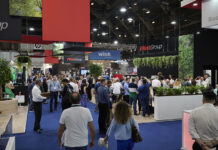David Peters, API’s creative development manager, tells Packaging Scotland how the latest holographic and luxury developments are driving innovation and helping brands to truly represent product values and add greater significance for consumers.
FOR the customer, the first point of contact for any product will often be the packaging, so its sphere of influence can be immense. The use of labelling can make a huge difference in how a product is perceived. Decorative foiling already adds stand-out shelf appearance, and now sophisticated use of holography within packaging design is also helping to generate greater interest from new customers.
Identifying Trends – Sophisticated Holographic Interplay
Brand owners operate in a highly competitive consumer marketplace, and are continually looking for new methods of product enhancement and differentiation. The unique visual effects of holography are increasingly providing a competitive edge by lending consumer products enhanced brand impact, point of sale appeal and a greater perceived value.
Building on this demand, API’s creative development service is providing knowledge of specialised uses of holography and 3D Designs through its new Holonique™ Boutique.
API’s Holonique™ Boutique uses a wide range of novel visual effects to create exciting and engaging holographic designs that make products distinctive, communicate brand values and attract more consumer interest. While holography is often used to protect against counterfeiting, it is its eye-catching appeal that is the core of API’s Holonique™ proposition. The bright colours and dynamic movement of a hologram, together with the traditional print on a pack, add the kind of depth and dimension with which consumers love to interact.
Through providing this unique interplay with print, holograms are helping brand owners realise their brand’s potential. Whether used as an integral part of the brand packaging for seasonal or promotional packs or for in-store impact, holography is providing great scope to creative and innovative designers, and helping to position products ahead of competitors by delivering first-class effects, from subtle sophistication to dynamic kinetic movement.
Defining luxury
Not surprisingly, consumers have varying opinions as to what exactly ‘luxury’ is, and this will also vary from market to market. What is important is that, as the term ‘luxury’ becomes increasingly widespread, brands work harder to define their place in the market. Whereas, in the past, using the correct combination of colours and styles could be effective, today this is no longer enough, and luxury packaging is now the result of a combination of materials, print and surface features that work together to deliver the best results.
As part of this, companies are seeking to provide consumers with a multi-sensory experience. Increasingly seen across consumer goods markets, holography, new print techniques, inks, laminates, foils and coatings are helping to add texture and interest to labels in order to meet the trend for more sophisticated ‘haptic’ packaging. The way in which a pack looks, feels, smells and performs is integral to the impression that a product can have on the consumer.
Keeping up to date with the latest trends is essential in order to ensure packaging contributes to a brand’s success. Luxury and premium goods are making sure their packaging effectively conveys their brand values by acting as a ‘second skin’ through representing and highlighting the product and brand qualities. The use of holographics, bold and bright colours and metallic finishes that interact with the latest print technologies – as well as the incorporation of softer tactile finishes that help represent femininity or luxury – demonstrate how premium packaging techniques are becoming truly relevant to brands and driving innovation.













